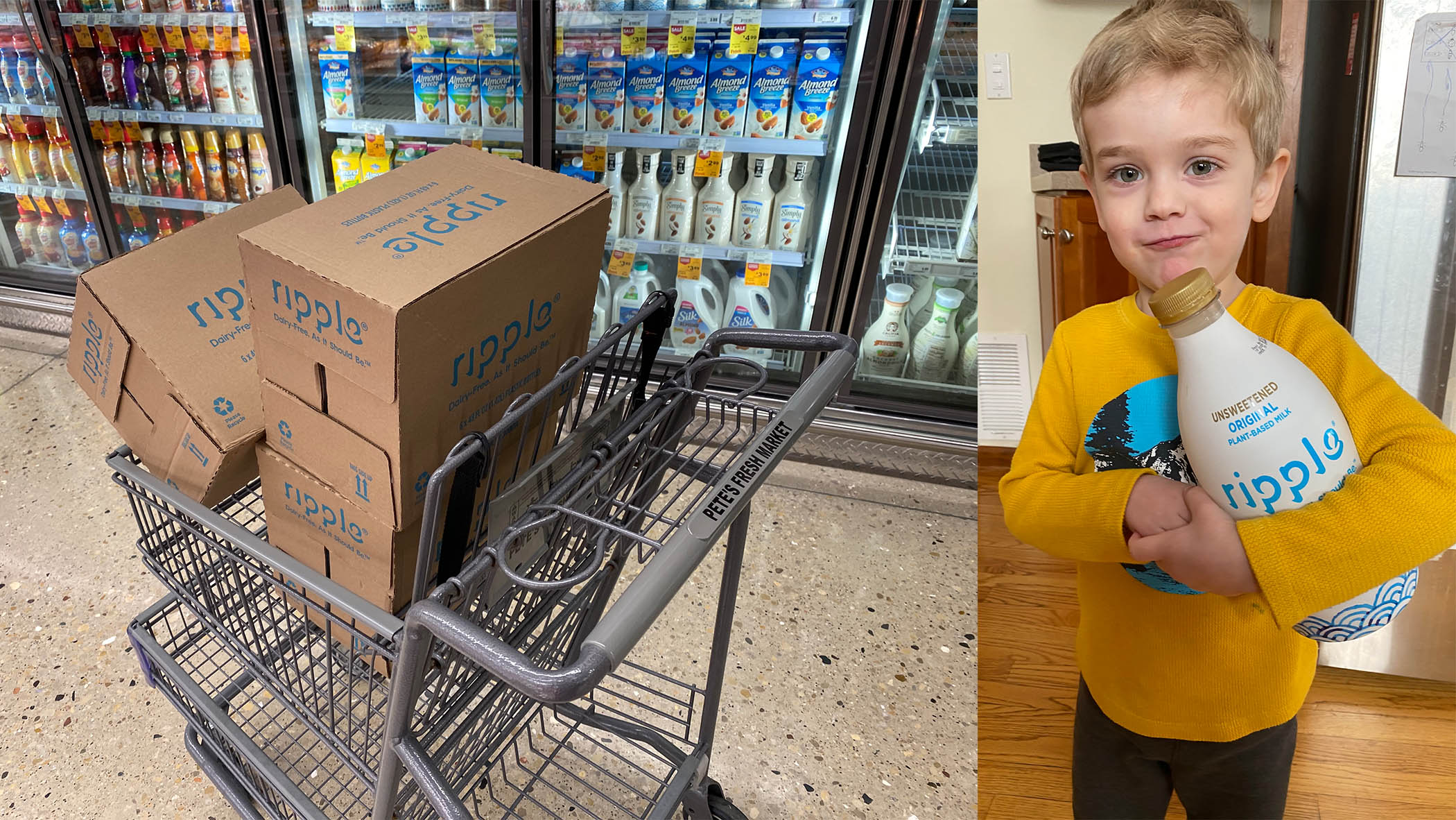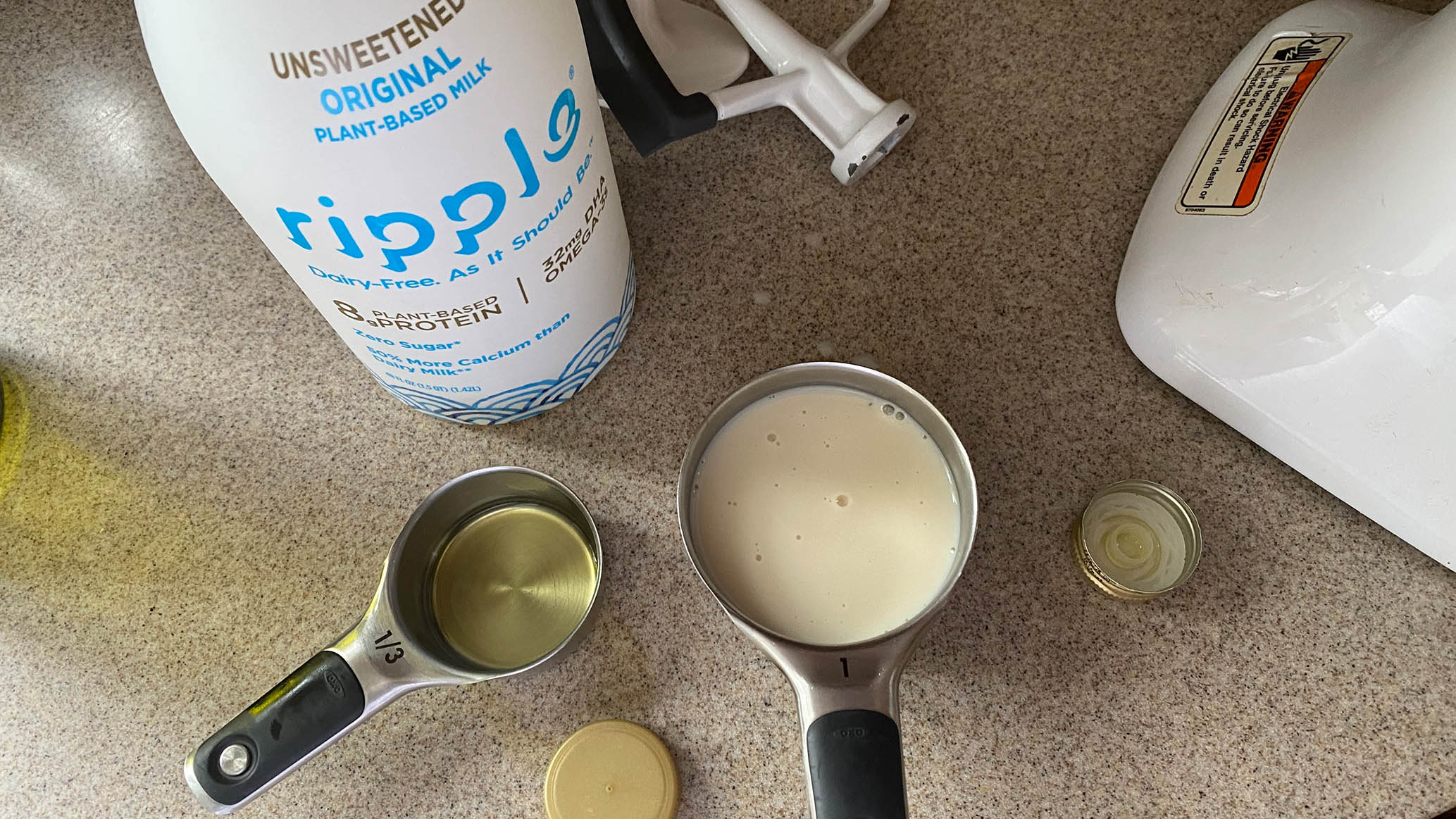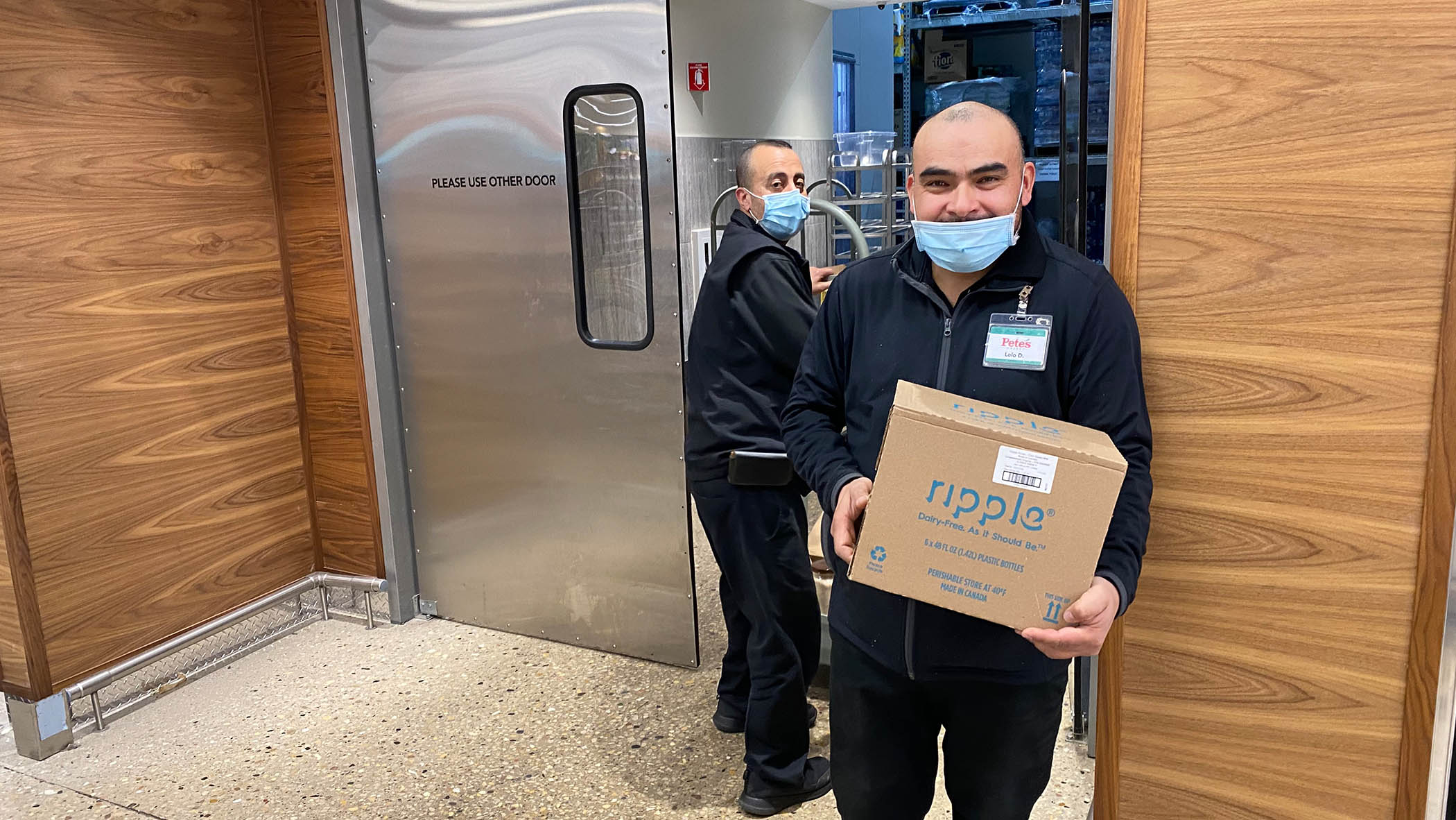When The Search For Alternative Milk Took Over My Life
In order to manage my child's allergies, I began the endless search for a dairy alternative.
Whenever I mention that my son drinks "Ripple," older adults momentarily think I'm talking about the cheap fortified wine that was popular in the 1970s. For the record, I'm not a lush who serves alcohol to my preschooler.
Ripple, in 2021, is much more likely to refer to a brand of dairy-free, gluten-free, plant-based non-GMO "milk" made from pea protein. Two years ago, I had no idea this product even existed, but my family's eventual journey into drinking Unsweetened Original Ripple is one that began out of desperation.
In 2019, I had a major problem. My son, then a toddler, was breaking out in hives, rashes, and red blotches that would appear on his face, stomach, and other regions of his body. As a baby, he had eczema. He'd frequently spit up milk and food. His tummy would puff up. I was an active breastfeeder, but he never seemed to get enough; his weight plummeted from the 95th percentile down to the eighth percentile and rode a rollercoaster. I purchased donor milk and tried a variety of formula types, and even purchased the German-based Holle formula that was supposed to be easier to digest and gluten-free. Still, my son continued to get rashes and cry out in pain. I knew I needed to do something.
A needle in a haystack
In addition to his other conditions, my son constantly had ear infections as a toddler. I suspected a dairy allergy might be the common denominator, but several pediatricians discounted my concerns.
At 18 months old, my son had surgery to address the infections. Small holes were made in my son's eardrums and ear tubes were inserted to help drain fluid out of the middle ear. His adenoids, an important part of the lymphatic system that clears away infection, were removed because they were so inflamed.
After surgery, my son's hearing checked out fine, but we didn't see much improvement with my son's speech, which had also regressed. That's when our dietician, Florence DiMarco, made a brilliant suggestion: have the doctor do a laryngoscopy, in which a scope is sent through the nose to check the throat for scar tissue. Finding inflammation in the throat would provide the medical evidence we needed to prove my son had a severe dairy allergy, after other testing was inclusive.
Sure enough, the doctor was astonished by the amount of scar tissue he found in my son's throat and suggested putting him on acid reflux medicine. I ignored his advice and opted to do what DiMarco recommended: I cut all dairy from my son's diet.
Within two weeks, I saw a marked change. My son started smiling again. He started to babble more. I suspect the inflammation was so great it held him back in ways I will never know.
The soy-free, nut-free, dairy-free search
To get my son off dairy, I needed a milk alternative. But because of my son's other allergies and sensitivities, finding a nondairy milk that didn't trigger other reactions was complicated. There were multiple other dietary restrictions—gluten, eggs, dairy, quinoa (which is in a ton of gluten-free items), eggs, mangoes, oats that aren't organic and certified-gluten free, peanuts and some tree nuts—all of which meant that I had fewer options than other parents who buy plant-based milks.
We weren't 100% sure on almonds yet, but suffice it to say that most nut milks were out. Oat milk wasn't an option either, because my son was getting blotches on his face from oatmeal—we later realized this was because the oats weren't certified gluten-free and organic. It was recommended that children who have dairy and gluten issues should avoid soy, which knocked out another possibility.
That's when DiMarco suggested Ripple, a pea protein blend that uses sunflower oil and has more protein than almond or coconut milks.
We opted for the refrigerated variety of Unsweetened Original Ripple (rather than the shelf-stable variety), which doesn't have added sugars or flavors. The neutral flavor was tasteless when cold, making it palatable enough for this dairy-lover to put on her cereal. Because it has more protein than watery almond milks, it's also easier to incorporate in gluten-free, vegan baking. In fact, if you didn't know it was plant-based, you might think Ripple was cow's milk.
When I started buying Ripple in 2019, many grocery stores didn't sell it. Big box stores did not reliably stock it either, and Target only kept it in limited supply. In Wisconsin, where my family frequently goes during the summer, Unsweetened Original Ripple was nonexistent once you got north of Milwaukee. Even now, it's still very difficult. In the dairy state of Wisconsin, it can be at least an hour's drive each way.
Unlike a lot of hard-to-find grocery products, you can't simply buy this stuff in bulk online for a decent price. If it's left out too long it will spoil; that's what has happened every time Target has had a sale and I've tried to reserve a couple of bottles through its app for order pick-up. Several times, I've gotten home and realized after opening a few bottles that the Ripple has soured into chunky clumps. (Although Ripple Foods makes a shelf-stable variety, it just isn't the same. It's like eating a can of beans versus fresh ones—there's no comparison.)
Finding a “dairy dealer”
With an underweight toddler chugging through the "milk," I needed to buy bulk quantities. My son was drinking at least one 48-ounce, 1.5-quart bottle of Unsweetened Original Ripple every day. At an average of $4.99 a bottle (and sometimes up to $6), that's like drinking a fancy Starbucks each morning; I was easily spending over $150 a month on Ripple. My son's milk consumption quickly became a line item in the budget. As his weight began to tick slightly higher into the healthier range, I become obsessed with finding him more milk.
That search often required going to four or five grocery stores to find enough for a week's worth of "milk." Sometimes I'd arrive at a store only to find the last bottle had just been sold, even after asking for it to be put on hold. Sometimes it required shopping in both Chicago and the surrounding suburbs. I was making myself crazy. If it was on sale for $3.49, I'd buy as many bottles as I could—sometimes 18 at a time—to stock up.
After weeks of driving from store to store, I knew I needed to centralize my shopping. I needed a "dairy dealer," someone who would sell Ripple to me in bulk quantities from one location.
I began asking grocery stores if they were willing to sell me two cases of Ripple at a time. This involved walking right up to the refrigerated section and knocking on the door. At first, no one would work with me: Target, Whole Foods, Jewel-Osco, and Mariano's all declined. Politely and persistently, I continued asking everywhere I could think of. In the meantime, friends and family would keep up the search, calling me whenever they saw Ripple on sale and presenting me with a bottle or two when they visited our house, much like a party hostess might receive flowers.
Eventually, I went shopping at a Pete's Fresh Market in my hometown of Glen Ellyn, Illinois. Yet again, I knocked on the door of the refrigerated section to see if I could purchase additional bottles since the shelves had been wiped clean. That's when I met Eliodoro "Lolo" Diaz, the dairy department manager. He saw my son, heard about his food allergies and sensitivities, and offered to help.
"It's what I would do for any of my customers," Diaz says. "We will try to do anything we can. I'd rather have you shop here than somewhere else. If we can help out, why wouldn't we?"
For months, Diaz held back two cases (12 bottles) of Ripple for me at a time, which would last about two weeks. When I needed it, I could usually get more.
Over time, I got to know Diaz. I learned that he is the youngest of five children and had immigrated from Mexico City. He became one of the unsung essential worker heroes of the pandemic. What he has done, by allowing me to purchase Ripple in bulk, has made a huge difference in my child's life.
It also keeps me conscious of the fact these types of allergies and health conditions can unfairly impact families that don't have the financial resources to help their children who desperately need alternative options.
Managing allergic reactions
"Mommy, I hope I can have dairy when I grow up," my son recently told me.
As a parent, it can be maddening to manage a child's dietary restrictions. I'm always reading labels, asking about cross-contamination. I can never just "pick up and go." If I forget to pack enough food, finding a place to eat is a complete nightmare. I always call ahead and talk to a restaurant owner. Most are willing to let me bring in outside food, after I explain my son might react to 10 different ingredients and I re-emphasize that I will be a paying customer.
A simple playdate involves bringing enough food not only for my son, but also the other kids, who usually want to try what he's having. To keep the supply of Ripple cold, I now use a stealthy watermelon cooler bag that looks like an oversized colorful purse.
I loathe the ice cream truck. Finding a place that sells dairy-free ice cream (that isn't made from coconut) is nearly impossible. Sorbets are usually lemon and mango varieties geared toward health-conscious adults, flavors that are either much too sour for my child's palate or a trigger for his allergies, respectively. Zarlengo's strawberry Italian ice (which I can buy at Andy's Frozen Custard) has been our saving grace.
But sometimes I'm reminded in delightful ways of how this struggle, this endless search for alternatives, is well worth it. A few weeks ago, we found a paleta vendor who sold a watermelon frozen treat that didn't contain dairy. When he found out, my son squealed with delight, nearly crying. The paleta vendor seemed stunned by our reaction. When I told him this was the very first time my son could have a shared experience with the other kids at the park, all of them eating the exact same thing, he shook his head in disbelief. I almost couldn't believe it myself.



